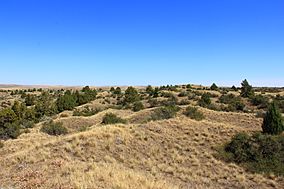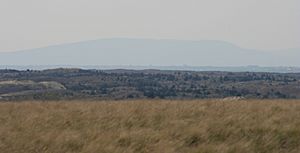Juniper Dunes Wilderness facts for kids
Quick facts for kids Juniper Dunes Wilderness |
|
|---|---|
|
IUCN Category Ib (Wilderness Area)
|
|

Juniper Dunes
|
|
| Location | Franklin County, Washington, USA |
| Nearest city | Pasco, WA |
| Area | 7,140 acres (28.9 km²) |
| Established | 1984 |
| Governing body | United States Department of Interior Bureau of Land Management |
The Juniper Dunes Wilderness is a special protected area in Franklin County, Washington. It covers about 7,140 acres (which is about 28.9 square kilometers) of land. This wilderness was created in 1984. It's famous for having the most northern group of western juniper trees. These trees grow among the area's big sand dunes, making it a unique place!
Animals and Plants of Juniper Dunes
This wilderness is home to many different animals. You might see mule deer, bobcats, and coyotes roaming around. Smaller animals like badgers, skunks, weasels, and porcupines also live here. You can also find pocket gophers, kangaroo rats, and several kinds of mousees.
The sky above is busy with birds such as hawks, owls, ravens, quail, partridge, pheasant, and doves. Many different songbirds also make their homes here. Just like in many wild places, you might also find rattlesnakes, so it's good to be careful and aware of your surroundings.

Besides the special juniper trees, not many other large trees grow in this area. However, there are many other interesting plants. You can find rubber rabbitbrush and green rabbitbrush. Grasses like bluebunch wheatgrass and Indian ricegrass are also common.
Other unique plants include white sand-verbena, Franklin sandwort, and sicklepod milkvetch. You might also spot turpentine cymopterus, hymenopappus, and prickly pear cactus. Colorful flowers like sand-dune penstemon, lanceleaf breadroot, sand dock, Carey balsamroot, wild-hyacinth, larkspur, and wild flax add beauty to the landscape. Finally, snow buckwheat, desert parsley Indian-potato, and silverleaf phacelia also thrive here.
How to Visit Juniper Dunes
It can be a bit tricky to get to the Juniper Dunes Wilderness. This is because all the land around it is owned by private people. This means there isn't a public road or path directly into the wilderness area.
However, in early 2007, an agreement was made with the landowners. This agreement allows visitors to use some old jeep trails that lead close to the wilderness boundary. But remember, you need to get permission from the landowners first before you can use these trails. This helps keep the area protected and respects the private property around it.

